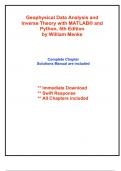Exam (elaborations)
Solutions for Geophysical Data Analysis and Inverse Theory with MATLAB® and Python, 5th Edition by Menke (All Chapters included)
- Course
- Institution
Complete Solutions Manual for Geophysical Data Analysis and Inverse Theory with MATLAB® and Python, 5th Edition by William Menke ; ISBN13: 9780443137945....(Full Chapters are included).
[Show more]



